2016 Wheat Disease Updates
Sunflower District Stripe Rust Update (5-13-16)
Variety Responses to Stripe Rust and Fungicide Residual Activity
from Jeanne Falk Jones, K-State Multi-County Agronomist
One of the things we have been talking about is how varieties respond to stripe rust. I thought I would share some pictures with you on what you might be seeing in the field for susceptible and resistant varieties. The stripe rust pustules on the susceptible should look quite robust, orange and these pustules you should be able to easily see or feel on the leaf. Susceptible varieties are Brawl CL+, Byrd, Denali, LCS Wizard, TAM 111 and TAM 112. I have attached two pictures of stripe rust on susceptible varieties – Byrd and Denali. In some research plots on the K-State Experiment Station in Colby, stripe rust is showing up on the flag leaf in Denali that has a very thick stand.
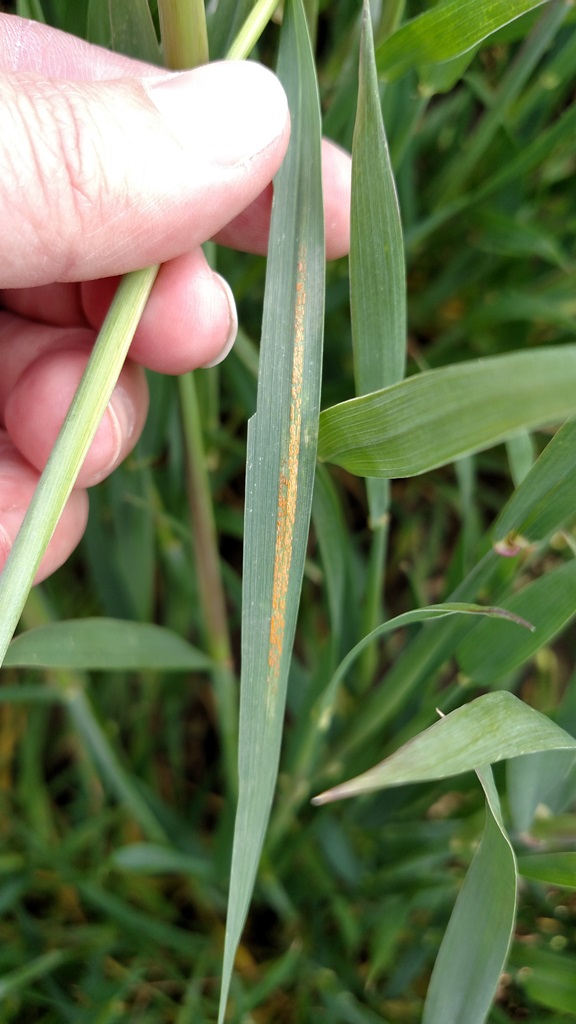
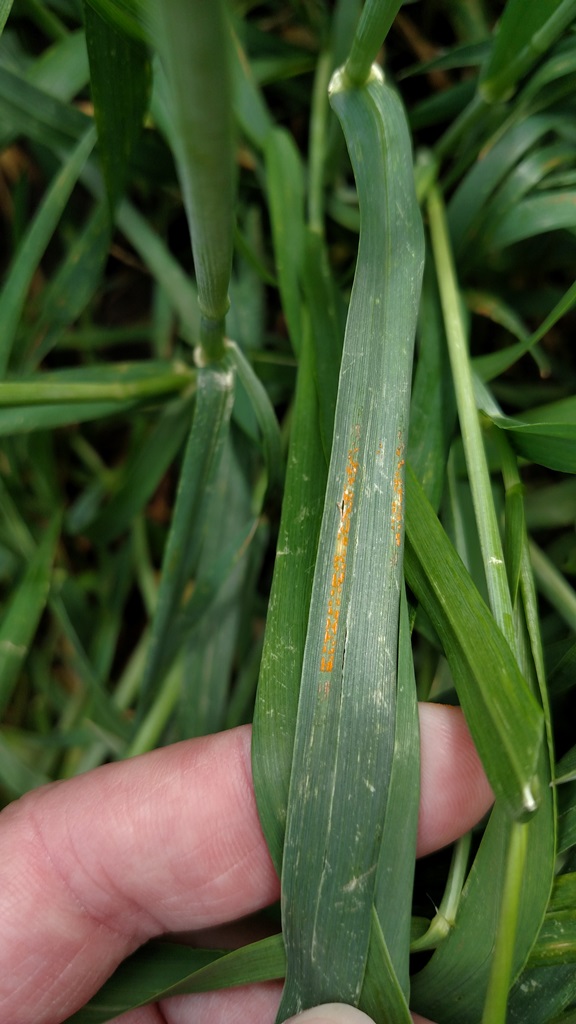
Here are also some pictures of how resistant varieties are responding to stripe rust – Cedar and Grainfield. Their rating is 3 on a scale of 1 to 9, where 1 is resistant and 9 is susceptible. These pictures show very small orange pustules in the center of a necrotic rectangular area of the leaf. Those pustules look pretty puny (not a technical term) and don’t seem to have the spore production of the susceptible varieties (little to no orange on my fingers when ran over the area).
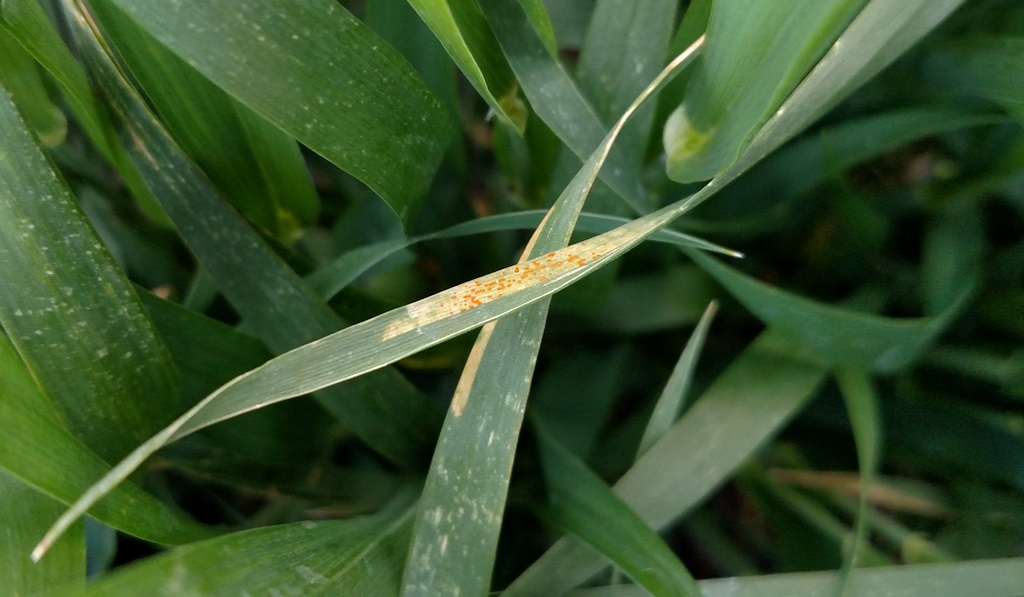
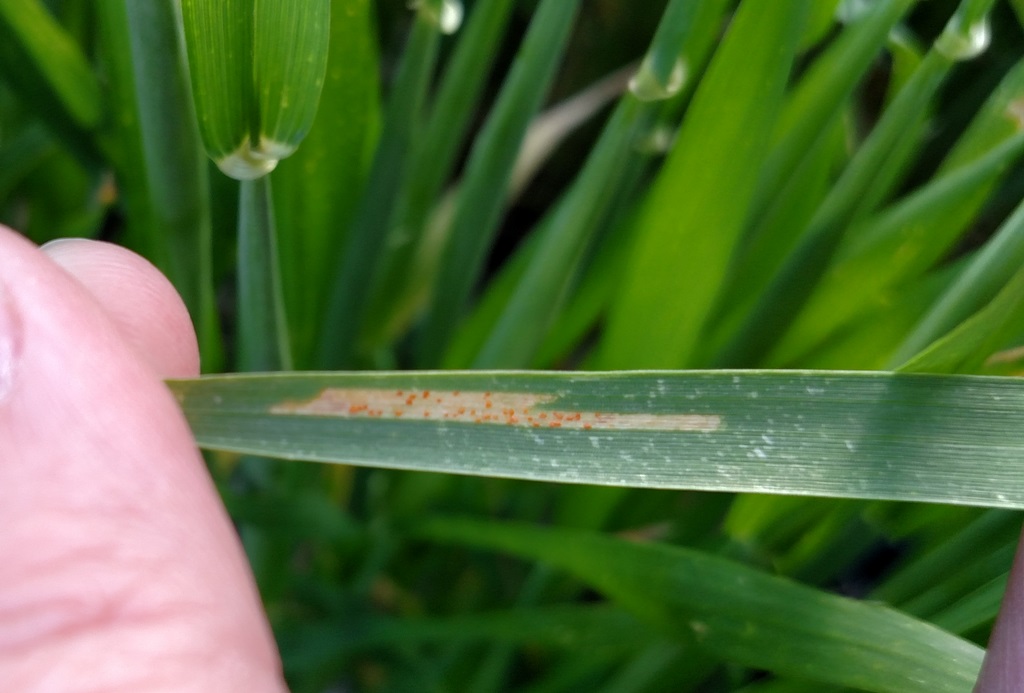
Residual life of fungicides is continuing to be a topic of discussion. I have attached a couple charts detailing some research from K-State. One chart shows severity of stripe rust on the flag leaf at 30 days after application for several fungicides and the related yields. The second is a series of charts to show the change in disease severity over time after fungicide applications. These charts are based on leaf rust and tan spot. However, we focus on these trials because we have multiple observations of disease within a season to help show the change in the disease severity over time. The fungicide residual life is consistent across stripe rust and other leaf diseases we have tested. 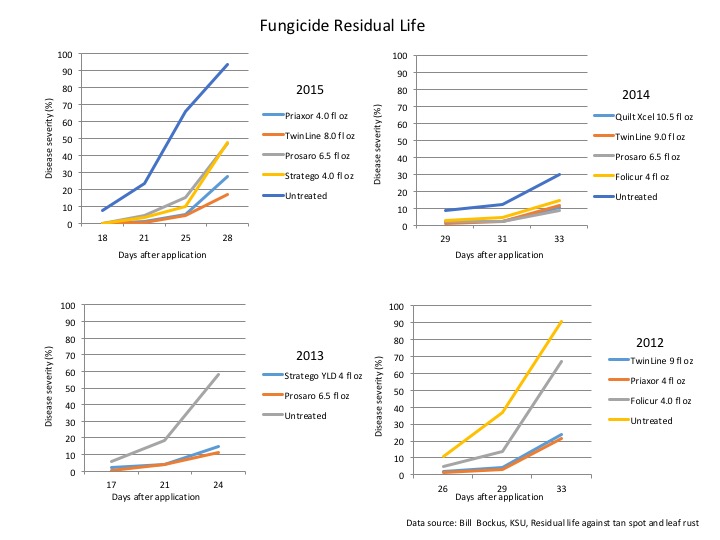
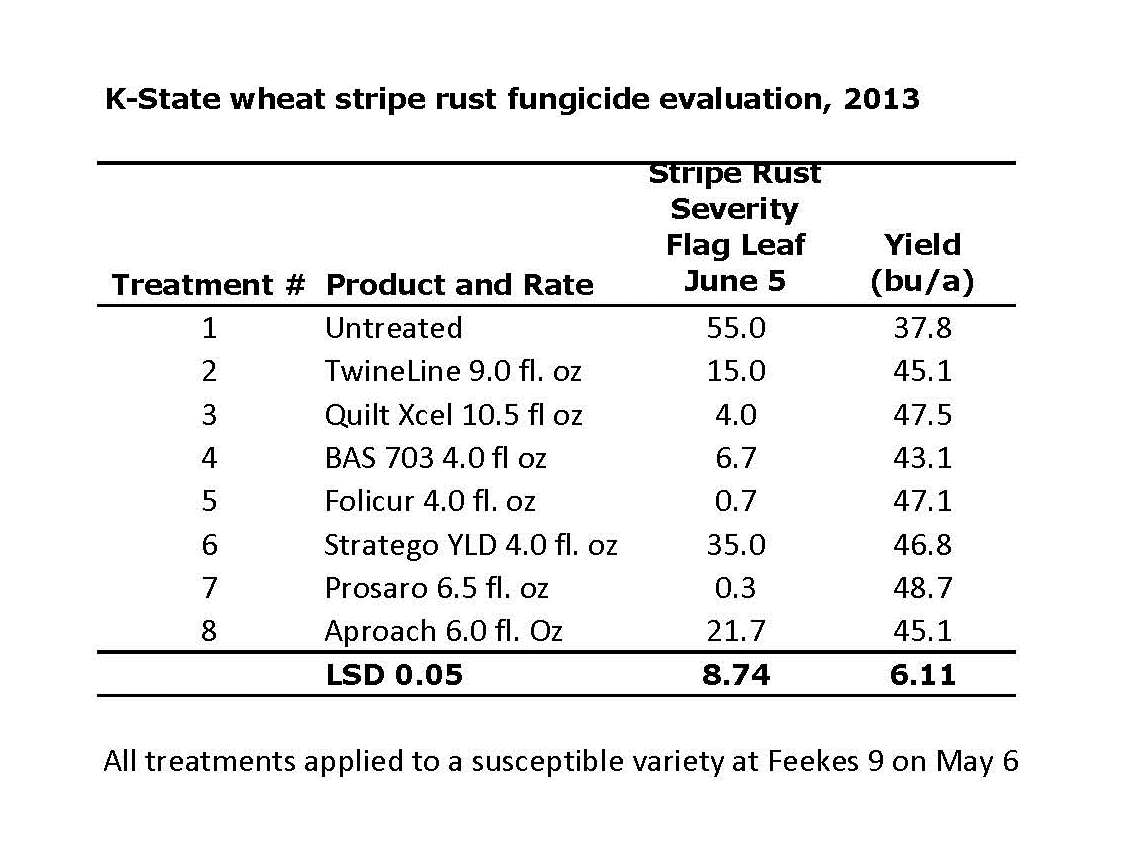
I do have a fungicide study out on the K-State Experiment Station in Colby. It is 16 different treatments (containing 13 different fungicides) on a thick field of Denali. There is plenty of stripe rust to test the products ;) Erick and I will be doing multiple evaluations on the plots to get a good look at what is going on.
Sunflower District Wheat Update (5-6-16)
Yellow Flecks on Leaves and Purpling of Stems and Leaves
from Jeanne Falk Jones, K-State Multi-County Agronomist
As everyone is out looking for stripe rust in their fields, we are finding other odd things! The things I am getting the most phone calls on are yellow speckles/flecks on the leaves and purple leaves, stems and heads.
Let’s first address the yellow flecks that are showing up on the leaves. I have attached a picture of them. They are very noticeable if the leaf is held up to the sun. The specks can be a response to a couple of things - environmental stress or stripe rust. If they are quite small and are randomly scattered throughout the leaf surface, they are likely a response to an environmental stress. In our case in northwest Kansas, it is likely a response to the cold temperatures last weekend.
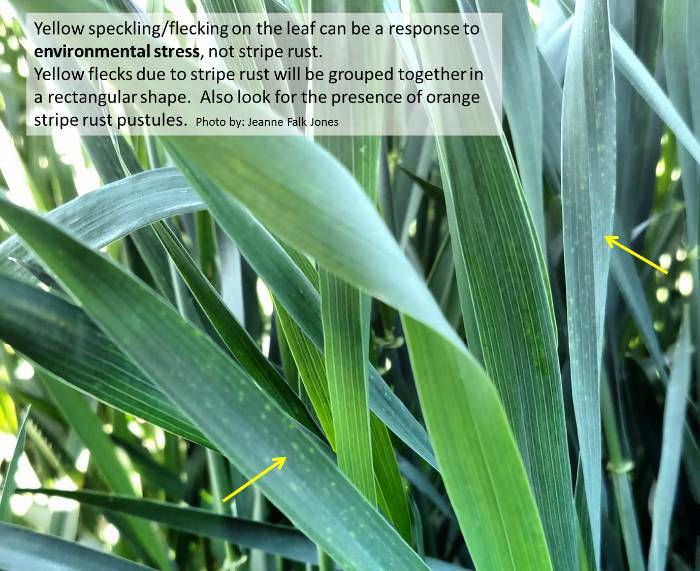
If the yellow flecks are concentrated together in a rectangular or circular shape, they may be the precursor to stripe rust. This type of shape is generally the shape of a group of stripe rust pustules. Also, be sure to look closely for a newly emerging orange stripe rust pustule.
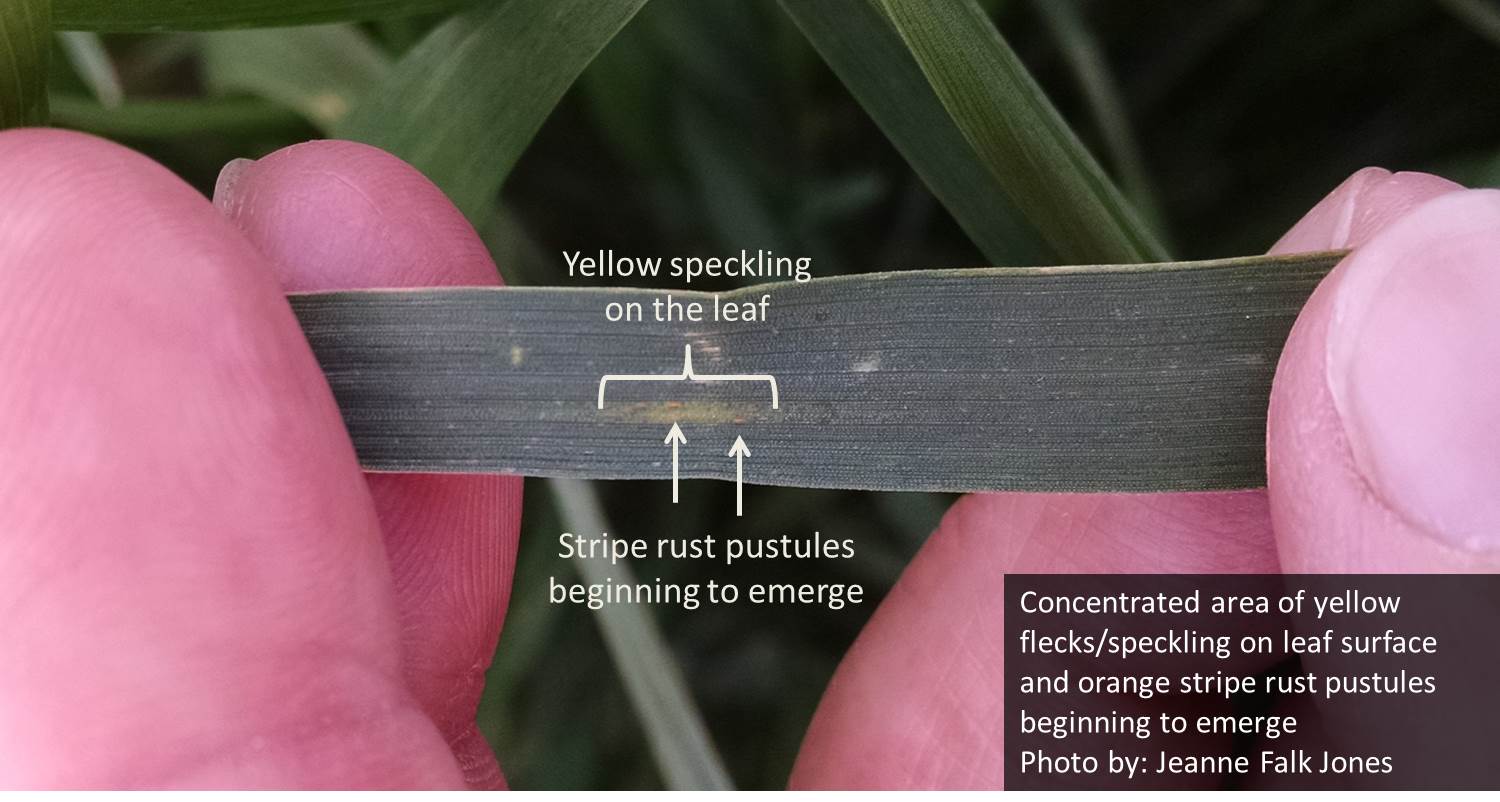
I hope that doesn’t confuse anyone, I just wanted to make sure everyone understands that visible yellow flecks on the leaf does not always equal stripe rust. Look for a grouping of them and the presence of orange stripe rust pustules.
Now let’s talk about the purpling on the wheat plants. The purple color is also a response to stress. I have predominately seen it on stems, but can be found on our wheat on stems, leaves and even heads. I have attached a couple pictures of the purpling on wheat. The purple color is because of an accumulation of sugars in that area of the plant. Many times, this had occurred on some of the last tissue to be exposed to the elements (the last tissue to emerge from the whorl of leaves. I began seeing it after the cold temperatures last weekend, so I believe it is a response to the cold temps.
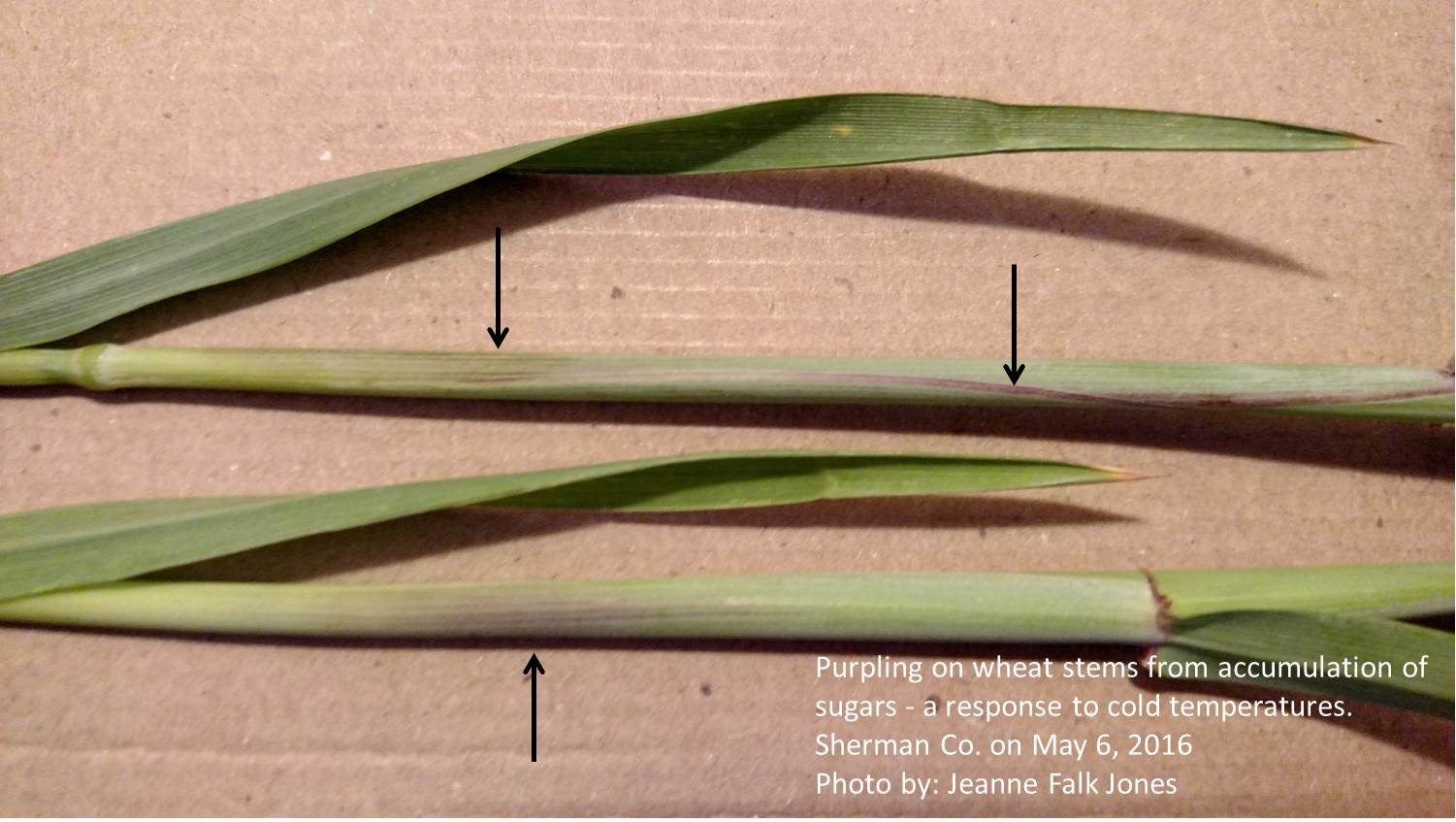
We commonly think of purpling showing up on young corn or sorghum stems or under leaves as a response to phosphorus deficiency. Our wheat is not showing phos deficiency this late in the season, but is responding to the cold temperatures.
Finally, if you have been looking at fields and having trouble finding stripe rust, be sure to check your variety’s resistance/susceptibility to stripe rust. In many cases, that can help unravel the questions of why it may be easier to find in some fields and harder in others.
Sunflower District Wheat Update (5-5-16)
Aphids in Wheat
from Jeanne Falk Jones, K-State Multi-County Agronomist
I have been getting questions about aphids in wheat and how to know if or when to control them.
The aphids that are being found in wheat are predominately the bird cherry oat aphid. These are a dark, olive green color. The others that might be found are greenbugs. They are a light green color with a darker bluish-green stripe down their backs. It seems like right now we are seeing more than may than you might be expecting. After the cold temperatures from last weekend, they are being found clustered lower in the canopy – where it is warmer. You may be also noticing different sizes of aphids. That is common because they give live birth, so you may find several small aphids around a single larger aphid.
You should also be noticing lady beetles and lacewings in the field also. That is because they are feeding on aphids. The beneficial insects – lady beetles and lacewings – are an important and effective control of the aphids. The aphids are like an all-you-can-eat buffet for the beneficials! If you apply an insecticide to control the aphids, you will also control the beneficial insects. The problem with that is the aphids can move on the wind because at certain stages of growth, they have wings. If aphids move back into the field, before the beneficials have had the time to repopulate the field, it can create a challenging situation.
The economic threshold for bird cherry oat aphids is 20-50 or more aphids per tiller. The lower number is for stressed wheat and the higher number is for wheat that is in good shape. The 50/tiller is a good threshold for most of the wheat in the area because our wheat really isn’t suffering from a great deal of stress.
Sunflower District Wheat Update (5-2-16)
Overnight Lows for May 2
from Jeanne Falk Jones, K-State Multi-County Agronomist
Here are the air temperatures and 2” soil temperatures from May 1 to May 2. The temperatures this morning were a bit cooler than I expected. There are some temperatures of 28 degrees or below in Cheyenne, Sherman and Wallace Counties. The chart shows the injurious temperatures is 28 degrees for 2 hours at the boot stage.
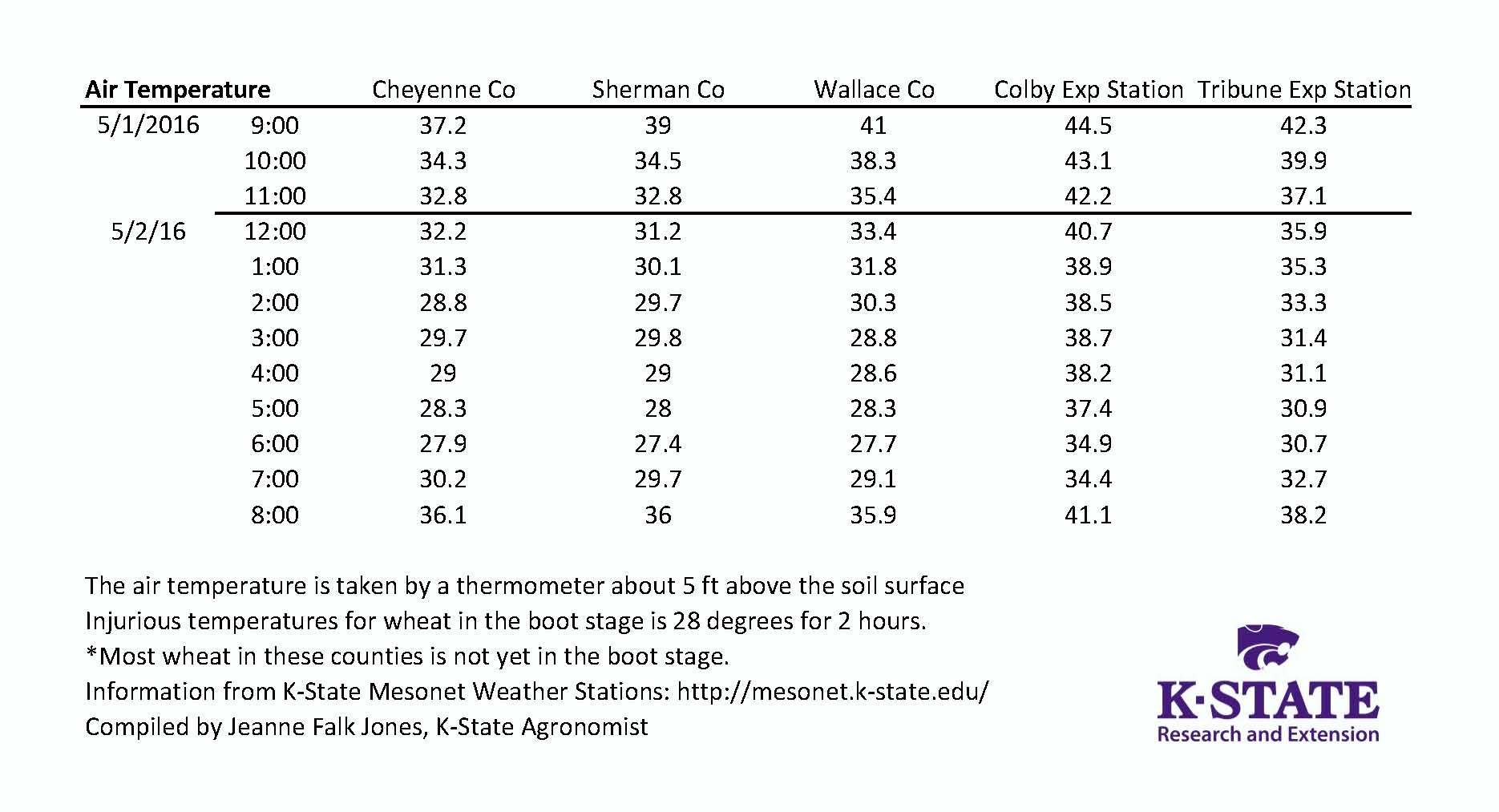
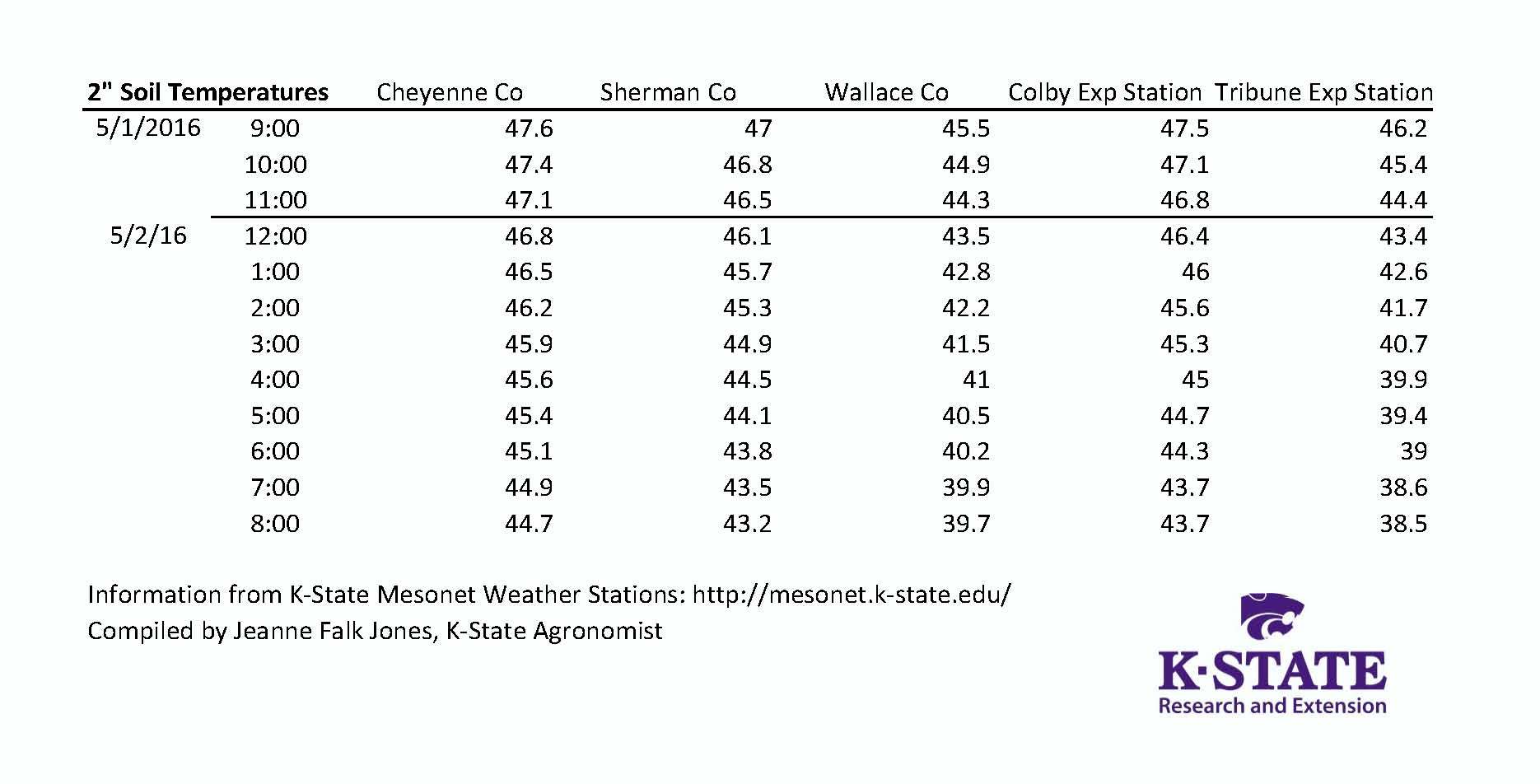
Please note that the soil temperatures are taken about 5 feet above the ground, and therefore may measure colder than the air around the wheat. The soil temperatures are still fairly warm and may help warm the air around the developing wheat head. Although there is some wheat further along with its development, most of the wheat is not yet in the boot stage.
It will take 10 -14 days to know the full extent (if any) of freeze damage. Freeze damage at the boot stage can result in the following symptoms:
- floret sterility
- spike trapped in boot (from damage or crimping of the collar of the flag leaf)
- damage / splitting to lower stem
- leaf discoloration
- odor.
I was out this morning and afternoon looking at wheat and didn’t notice a ‘silage’ odor, leaf discoloration or any damage to the lower stems. If you noticed any of these symptoms, please let me know.
Here is also a picture of wheat in the boot stage and a graphic showing the different stages of development from flag leaf emergence to flowering.
Sunflower District/Thomas Co/Rawlins Co Stripe Rust Update (4/23/16)
from Jeanne Falk Jones, K-State Multi-Count Agronomist
I spent quite a bit of time in the field yesterday looking for stripe rust. I found it in trace levels in the plot in Cheyenne Co and the plot in Sherman Co. Now when I say trace level, it means I spent probably 20 minutes looking to pull out 2 or 3 groups of pustules. I always seem to underestimate the amount of time I spend in the field and didn’t make it to the plots in Wallace Co. They are high on the priority list!
When I was looking in the plots, I looked specifically at varieties rated as susceptible for the stripe rust. Those varieties (that are popular in western Kansas) are Brawl CL+, Byrd, Denali, LCS Wizard, TAM 111 and TAM 112. These varieties are rated as 7 or 8 on a scale of 1=Highly Resistant and 9=Highly Susceptible. Here are some popular varieties that are rated as intermediate: KanMark – 6, Mint – 4, LCS Pistol – 5, Wolf – 4, WB 4458 – 4 and Winterhawk – 6. Varieties that are rated as 2 or 3 are: Oakley CL – 2, Monument – 2, T-158 – 2, TAM 114 – 2, WB Cedar – 3, and Grainfield – 3. Please remember even the varieties ranked as 2 or 3 will develop stripe rust pustules, especially in years with high stripe rust pressure.
All in all, I get lots of detailed questions about different products and the timing of applying them. When in reality, the most important decision is the first one…Do I spray fungicide on my wheat? Here is the list of things I use to make a fungicide decision – 10 day forecast, likelihood of high stripe rust pressure, yield potential of wheat, susceptibility of variety and stage of wheat.
- 10 day forecast. We are predicted to have cool temperatures and moisture – just what stripe rust loves.
- Likelihood of high stripe rust pressure. If you look at the map of Kansas, we are not seeing many counties colored for stripe rust pressure. My prediction is that will change during this next week. Stripe rust is being found in northwestern Texas and we have had just a bit (lots) of south wind during the last two weeks.
- Yield potential of my wheat. I don’t like to make wheat yield predictions, so you can do that!
- Susceptibility of variety. I addressed that earlier, but please remember even resistant varieties can develop stripe rust pustules.
- Stage of wheat. We are actually in a great stage of growth to be able to address stripe rust pressure. We have a bit of time before flag leaves fully emerge from the whorl and stripe rust is just starting to be detected, so we have time to get a plan in place.
All in all, yield loss from stripe rust can be 50% loss with high stripe rust pressure, susceptible variety, weather conditions conducive to stripe rust development, and stripe rust moving in before or as flag leaves are emerging. This yield loss has been seen in research at the Colby station.
Now, I know you repeated the phrase yesterday, ‘I will not spray fungicide until the flag leaf is completely emerged from the whorl’. We discussed the fact that fungicide will not move from leaf to leaf. I did some further investigation and the typical movement of fungicides is around ¼ to ½ inch in the leaf. That isn’t very far. Therefore, coverage on the flag leaf, after it has emerged, is very important. In addition, applications of fungicides at labeled rates last around 21 days.
Here is a list of frequently asked fungicide questions that we put together, with answers from Erick DeWolf, the K-State wheat pathologist. I seem to seem to get lots of questions about generic vs branded products and ‘preventative’ vs ‘curative’ modes of action. These FAQs address both of those topics. Click here for a printable version of the Frequently Asked Questions.
I have several of the K-State stripe rust publications available on the K-State Sunflower District webpage. They include information on making the decision on fungicide treatments, varietal response to stripe rust, and efficacy of fungicides, please go to the K-State Sunflower District Wheat Disease page
Finally, if you know of someone who should be receiving email updates, please let me know and I will get them added to the list! If you have a question about all of this (stripe rust, fungicides or anything else), please let me know! I want folks to feel like they can make educated decisions, when deciding on treatment of stripe rust.
Thanks everyone being part of getting the word out about stripe rust and making educated decisions on the treatment of the disease! Remember, do not make fungicide treatments until the flag leaf has fully emerged from the whorl of the wheat plant ;)
State of Kansas Update (4/22/16)
from Erick DeWolf, K-State Wheat Pathologist
Reports of wheat stripe rust continued to roll in this week. The disease was already established in many parts of south central and southeast Kansas. Stripe rust has moved to the upper in some fields within these regions now. This movement to the upper canopy is important because these leaves contribute the majority of the energy used to make grain. The other key update comes from western Kansas where the disease was reported at low levels this week. The first reports came from irrigated fields but a few dryland fields were subsequently found to have stripe rust also.
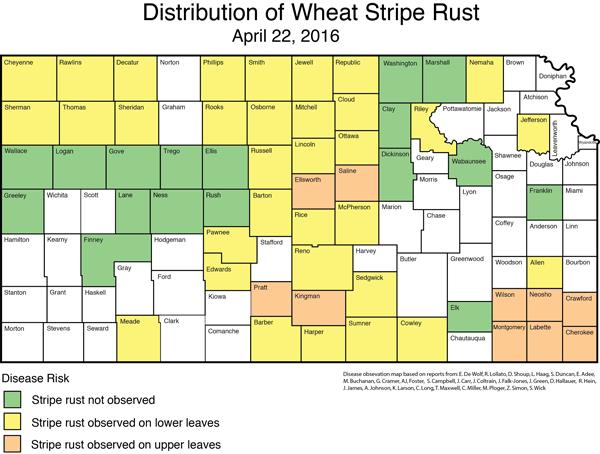
Sunflower District/Thomas Co/Rawlins Co Stripe Rust Report (4/22/16)
from Jeanne Falk Jones, K-State Multi-Count Agronomist
You are probably wondering what is going on with stripe rust, since we’ve had a couple days since the rain. Well, I had hoped that we might have another week of looking for the disease, but it is now being found in trace levels in northwest Kansas.
Now before we get into details, I want you to stop and listen closely… DO NOT spray for stripe before the flag leaf is fully out on the plant. Wait to make a fungicide application until the flag leaf is fully out of the whorl. This is essential for keeping the protecting yield from stripe rust with a fungicide application. And in most fields in Sunflower District, the flag leaves are still tucked into the stem and may be a week or more before they begin emergence.
So back to the details…
I got a phone call on Tuesday afternoon about trace levels of stripe rust being found in 2 irrigated wheat fields in northeastern Thomas Co/northeastern Sheridan Co. I thought, ‘OK, now we know active spores have been moving through the area with the wind and the irrigated wheat had more moisture to let the disease infect the leaf.’ It’s not super surprising.
Yesterday, I got a few more pictures and phone calls to include trace levels on some other irrigated wheat fields. Yesterday afternoon, Lucas Haag (the K-State Area Agronomist) and I went out to set up plots for a fungicide study and we found stripe rust in VERY trace levels in a field of Denali at the Experiment Station in Colby. The wheat in this dryland field is quite thick, so the canopy was still damp from the shower that was received on Wednesday. I then stopped at a random dryland field near Levant and found stripe rust in very low levels in the area of the field with the thickest stand. I have also had couple reports of dryland wheat in northern Thomas Co and southern Rawlins Co with trace levels of stripe rust showing up.
So, when the new stripe rust maps come out today from K-State, Thomas County will be colored to show stripe rust has been found in trace/low levels. I am going to spend most of the day in the field to see what else I can find in Cheyenne, Sherman and Wallace Counties. My gut instinct is that I may be able to find stripe rust in trace levels, but we need to wait to see what I find.
What now? The forecast looks conducive for stripe rust development. Looking at the 10 day forecast, we are going to have cool temperature and chances for moisture. These are the conditions that stripe rust likes.
There are a couple decisions that you will need to make over the next couple weeks. First, are you going to spray your wheat? If so, then when to make the decision to treat?
The decision of whether to treat or not to treat is a very important one and sometimes can be a challenging one. The good news is that you don’t need to make it just yet because the flag leaves are not out yet! So, we can see how the disease progresses over the next couple days. Several factors go to into making the decision to treat – the weather forecast, the stage of wheat, the susceptibility of the variety, and the location and severity of the stripe rust.
A general guideline that we have been using is this: if the flag leaf is out and you have a susceptible variety, the forecast is calling for cool and moist conditions and there are stripe rust pustules showing on one or two leaves below the flag leaf – make the fungicide treatment.
Make sure to repeat after me…I will not spray fungicides for stripe rust before the flag leaf has emerged. All fungicides have very limited ability to move around in the plant. They have what is called limited translocation, meaning the fungicide cannot move from one leaf to another leaf on the plant. It can move around in limited amounts within the leaf that the fungicide is applied to. That is why it is so important to be patient and wait until the flag leaf has emerged.
I will close for now and let you know what else I am finding tonight or tomorrow. I know you have probably heard me say, protect the flag leaf from stripe rust. That is still very true, but don’t treat with fungicides before the flag leaf has emerged. Otherwise, the fungicide will not get on the flag leaf to protect it.
For additional information on making the decision on fungicide treatments, varietal response to stripe rust, and efficacy of fungicides, please go to the K-State Sunflower District Wheat Disease page.
Finally, I want to say thanks to all of you for scouting your fields and relaying what you are finding to me! Together we have built a good network to help get field observations put together and sent out, so everyone can benefit from the information on what is being found! Please continue to let me know what you are finding in the field. Give me a call, snap a photo, drop me a text or send me an email…everything works!
Northwest KS / Sunflower District Stripe Rust Report (4/19/16)
from Jeanne Falk Jones, K-State Multi-Count Agronomist
With the moisture since last Friday, the big question is now about stripe rust in wheat. There are increased concerns about stripe rust infections after a rain event. To get an infection of stripe rust, there must be three things - wheat, stripe rust inoculum and moisture.
We know we have two of the three parts of the disease triangle – wheat and moisture. Is the stripe rust close? Stripe rust has not been found in northwest Kansas yet this spring. Stripe rust has been found in Colorado, north of Denver (because it overwintered in a susceptible variety) and through the central and eastern portions of Kansas. In addition, a report from Texas on Monday indicated that northwest Texas was just starting to see stripe rust infections. This means stripe rust is being found directly south of us – however – quite a distance south. Therefore, this year, we are watching two fronts for stripe rust movement – the south and the west.
We are really in the ‘wait and see’ stage to see if stripe rust makes its way to northwest Kansas. I am in the field looking for any indication of stripe rust and having conversations with colleagues about what they are finding. I will keep you updated on what is being found!
State of Kansas Stripe Rust Report (4/18/16)
from Erick DeWolf, K-State Wheat Pathologist
The recent rains across Kansas (Figure 1) will be beneficial to the wheat crop, but will also increase stripe rust activity on wheat. Stripe rust was already established at low levels in many areas of central Kansas and the recent rainfall greatly increases the risk that the disease will move the upper leaves soon (Figure 2). This movement to the upper leaves is important because they contribute most of the energy used by the plant to make grain. The disease has already reached the upper leaves in many fields in the southeast region of the state, which received more rain in previous weeks than other regions.
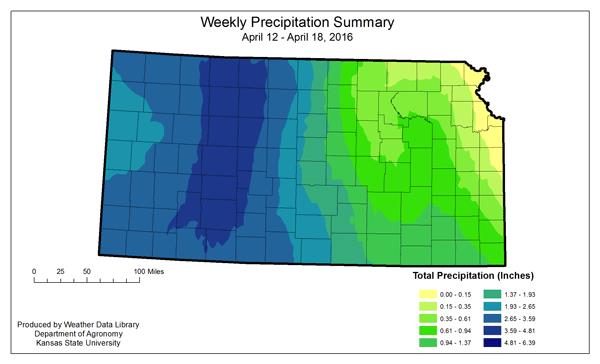
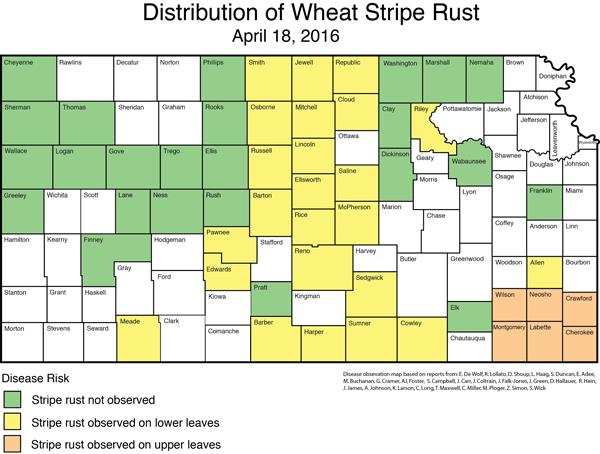
Where stripe rust was not yet present on wheat before the recent rains, producers have a little more time before making a decision about applying a fungicide. But it is still important to monitor for disease regularly. Fields planted to varieties susceptible to stripe rust should be scouted closely until the wheat is past the stage at which fungicides can be applied – which is flowering for most fungicides.
Where stripe rust was already present on lower leaves before the weekend of April 16-17, it may now quickly spread to the more critical upper leaves. A fungicide application now would likely be beneficial in those situations, depending on the yield potential of the crop.
In some areas of southeast and south central Kansas, stripe rust had already infected the flag leaf as of this past weekend. Where stripe rust is currently present on the flag leaves at low levels and most of the leaf’s green area is still intact, a fungicide application will still be beneficial in most cases. There is a point of diminishing return however. If the disease has already destroyed more than 25% of the upper leaves, the crop will be less likely to benefit fully from the fungicide application. In this case, the disease has already damaged a good portion of the leaf area and has likely already begun to infect much of the remaining green tissue. The remaining green tissue may still die even after the fungus has been suppressed by the fungicide.
In short, I think we are headed for trouble with stripe rust. Growers should be checking fields and ready to spray when the weather clears.
Wheat farmers have a lot of fungicide options to chose from although product availability may vary regionally in the state. Most of the products are rated very good to excellent on stripe rust (Table 1). In general, the largest reductions in disease severity and greatest increases in wheat yield or grain quality occur when fungicides are applied between full extension of the flag leaves and anthesis (when the male flower parts have just begin to emerge). Applications intended for the management of glume blotch or head scab should be made between the beginning of anthesis and 50 percent flowering. Always consult the product label for specific growth stage restrictions and preharvest intervals (PHI) before making fungicide application.
Table 1. Efficacy of many widely marketed fungicide products against stripe rust.
|
Fungicides |
|||||
|
Class |
Product |
Active Ingredient |
Rate (fl. oz./acre) |
Stripe rust rating |
Preharvest Interval |
|
Strobilurin |
Approach SC |
Picoxystrobin 22.5% |
6.0 - 12 |
Excellent** |
Feekes 10.5 |
|
Evito 480 SC |
Fluoxastrobin |
2.0 – 4.0 |
-- |
Feekes 10.5 and 40 days |
|
|
Headline 2.09 EC |
Pyraclostrobin 3.6% |
6.0 – 9.0 |
Excellent** |
Feekes 10.5 |
|
|
Triazole |
Caramba 0.75 SL |
Metconazole 8.6% |
10.0 – 17.0 |
Excellent |
30 days |
|
Tilt 3.6 EC* |
Propiconazole 41.8% |
4.0 |
Very good |
Feekes 10.5 |
|
|
Proline 480 SC |
Prothioconazole 41% |
5.0 – 5.7 |
Very good |
30 days |
|
|
Folicur 3.6 F* |
Tebuconazole 38.7% |
4.0 |
Excellent |
30 days |
|
|
Prosaro 421 SC |
Prothioconazole 19% Tebuconazole 19% |
6.5 – 8.2 |
Excellent |
30 days |
|
|
Mixed modes of action |
Absolute Maxx SC |
Tebuconazole 22.6% Trifloxystrobin 22.6% |
5.0 |
Very good |
35 days |
|
Fortix |
Fluoxastrobin 14.8% Flutriafol 19.3% |
4.0 – 6.0 |
Excellent |
Feekes 10.5 and 40 days |
|
|
Trivapro A EC + Trivapro B SE |
Benzovindiflupyr 10.3% Propiconazole 11.7% Azoxystrobin 13.5% |
4.0 + 10.5 |
Excellent |
Feekes 10.5.4 |
|
|
TwinLine 1.75 EC |
Metconazole 7.4% Pyraclostrobin 12% |
7.0 – 9.0 |
Excellent |
Feekes 10.5 |
|
|
Priaxor |
Fluxapyroxad 14.3% Pyraclostrobin 28.6% |
4.0 – 8.0 |
Excellent |
Feekes 10.5 |
|
|
Quilt Xcel 2.2 SE* |
Propiconazole 11.7% Azoxystrobin 13.5% |
10.5 – 14.0 |
Excellent |
Feekes 1.05 |
|
|
Stratego YLD |
Prothioconazole 10.8% Trifloxystrobin 32.3% |
4.0 |
Very good |
Feekes 10.5 and 35 days |
|
|
Approach Prima SC |
Cyproconazole 7.17% Picoxystrobin 17.94% |
3.4 – 6.8 |
Excellent |
45 days |
* Multiple generic products containing the same active ingredients also may be labeled in some states.
** Efficacy may be significantly reduced if solo strobilurin products are applied after stripe rust infection has occurred.
Source: Foliar Fungicide Efficacy Ratings for Wheat Disease Management 2016, K-State Research and Extension publication EP-130: http://www.bookstore.ksre.ksu.edu/pubs/EP130.pdf
Yellowing Wheat - Is It A Disease? (4/13/16)
I have also been getting questions about the yellowish cast that is being seen in many throughout the area. If you look closely, the lower leaves are the ones with the most yellowing – from light yellow to gold colored - showing up. Those leaves are also senescing or turning brown. The tips of the leaves, located just above the yellowing leaves, may also be showing tip dieback. However, all of the new growth is looking green and healthy.
I thought many of the symptoms didn't look quite like a disease (fungal, virus or bacterial), so I sent in several samples to the K-State Plant Pathology Diagnostic Lab. The results came back negative for all viruses (Wheat Streak Mosaic, High Plains Mosaic, Triticum Mosaic, Barley Yellow Dwarf and Soilborne Mosaic). They were also negative for fungal disease (all rusts, tan spot, septoria and root/crown rots). Finally, no bacterial diseases were found.
The results came back as environmental stress. Environmental stress can be related to many things, but I think it our wheat has actually been through quite a bit in the last month. The temperature swings have been below freezing to upper 70s. The wheat has also been exposed to blizzard conditions in the northwest corner of the state on March 23-24. In addition, we are continuing to see drought stress showing up on the edges of field or in compacted areas. Finally, nitrogen that was applied as a topdress application has likely not yet been moved into the root zone because of lack of rainfall. Nitrogen stress also shows up as yellowing and death of the lower leaves.
I also wondered if the yellowing was related to one variety or varieties with similar parentage. However, I have found or received samples from a wide array of varieties – SY Wolf, T-158, TAM 112, Denali, Winterhawk, Grainfield, Byrd and Brawl Cl+. That is quite a wide variety of parent lines as well.
In addition, it is not confined to one or two counties. I have looked at or received samples from Cheyenne, Sherman, Wallace, Logan, Thomas, Rawlins, Decatur and Sheridan Counties.
All in all, when I sent the samples into Manhattan, the plant pathologist called to say that I have been sending her some of the best looking wheat that she has seen in the lab. She thought a good drink of water would do our wheat a lot of good!
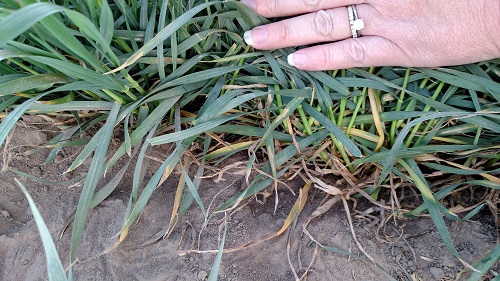
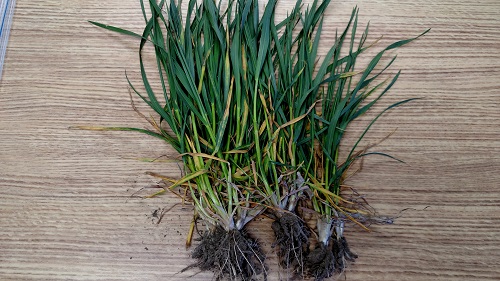
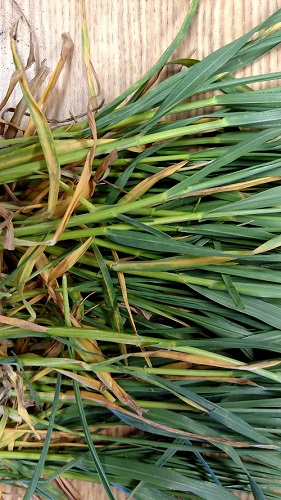
Jeanne's Report
Here is your stripe rust update. The map from April 8 is still showing the corridor of stripe rust infections in Central Kansas. There have been a few more counties added to the map from last week, but they are mostly filling in counties in south central and north central Kansas.
In addition, in the report that I received from Colorado this morning says that the reports of stripe rust in the Prospect Valley, around Keenesburg, seems to be staying localized and not moving very much. That is good news for us! The more concerning news from Colorado is that a trace amount of stripe rust has been found at Stratton. We are going to keep an eye that way to see if the trace levels start to increase or move.
So, what does that mean for us? Right now, we are still in the hurry up and wait phase to see if stripe rust starts to show up-which is a phase that I am very happy to be in! The moisture in the forecast is going to be great for the wheat. However, moist conditions are also good for stripe rust. We are going to continue to listen to the south (and now west) for new reports.
If-and it's a big "if"- stripe rust starts getting closer, it is important to remember the most important part is to protect the flag leaf. We are still quite a ways from flag leaf emergence. In nearly all wheat fields in the Sunflower District, the growing point has moved above the soil surface and many have placed the first joint above the soil surface. This is still many days from a flag leaf showing. Generally, we (K-State) does not recommend fungicide treatments for rust diseases until the flag leaf has emerged. A majority of the energy and nutrients to fill the head comes from the flag leaf, so that is why it needs to be protected.
K-State Whole State Report
The wheat crop in Kansas is now at the flag leaf emergence stage of growth in much of southern and central Kansas. The crop is at mid- to late-jointing in the west central and northwest regions of the state. Stripe rust continues to be our primary focus this week with new reports from additional counties and further disease development in central Kansas. The disease is still limited to the lower leaves for the most part with occasional mid canopy leaves with trace levels. The incidence of stripe rust on the lower leaves of susceptible varieties ranges from 1-30%.
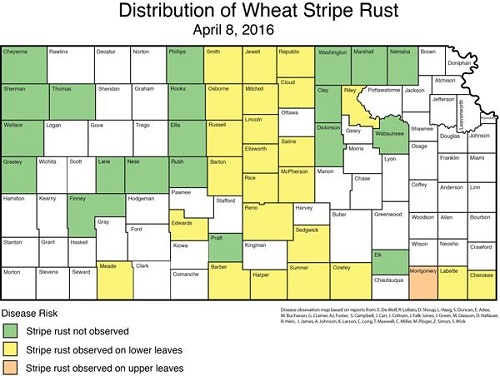
Leaf rust was observed at multiple locations in central Kansas this week also. As with stripe rust, leaf rust is also on the lower leaves. Only trace levels have been found so far in most plots. We did observe a few fields and plots in Reno and McPherson counties with incidence of leaf rust approaching 90% on the lower leaves. The severity of the infection was still low (<10%) in most cases.
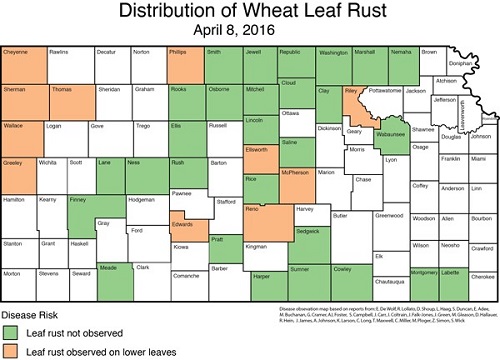
The dry conditions may be slowing the spread of leaf diseases temporarily, but the growers should be watching the situation carefully. Be prepared to apply fungicide if disease continues to progress.
Erick De Wolf, K-State Extension Plan Pathology
Romulo Lollato, K-State Wheat and Forages Specialist
from Jeanne Falk Jones, K-State Multi-County Agronomist
I have not found any signs of stripe rust here in northwest Kansas. However, it is important to keep checking fields for any disease.
Stripe rust is showing up through a central corridor of the state, reaching from Oklahoma to Nebraska. In addition, southeast Kansas has reports of infection levels on the upper leaves of the disease. In some cases, it is showing up one or two leaves below the flag leaf. They will soon begin making decisions on fungicide treatments.
There is still a report of stripe rust coming from northeast of Denver. Their update said that the symptoms have spread a bit, but not a great deal. Windy conditions may have moved the spores, but there has not been a great deal of moisture in the area to allow the spores to infect the leaves.
from Erick De Wolf, K-State Extension Plant Pathology and Romulo Lollato, K-State Wheat and Forages Specialist
The Kansas wheat crop is progressing rapidly through the jointing stages of development in much of the state. Wheat in the southeast portion of the state is at or fast approaching flag leaf emergence. The crop is generally considered to be two or three weeks ahead of schedule.
Scouting reports indicate that stripe rust has become established in the 2016 wheat crop. This past week, stripe rust was reported in many counties in central and eastern Kansas (Figure 1).
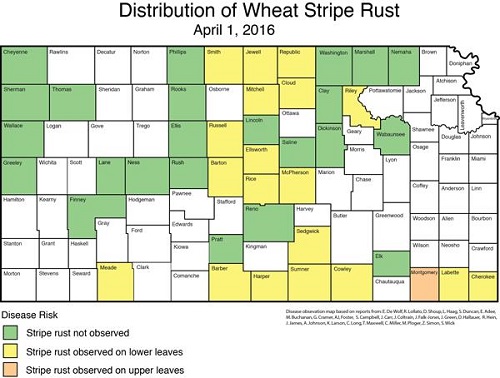
The disease is still at low levels in most fields with a few exceptions in southeast Kansas. This early establishment of stripe rust increases the risk of severe yield loss and growers should continue to monitor the situation carefully. If weather conditions become favorable, the disease could spread rapidly from the lower leaves, where it is now established, to the upper leaves critical for grain development.
Growers should check their fields for stripe rust as the crop approaches flag leaf emergence and heading. Fields with stripe rust still in the lower canopy at heading are at a moderate risk for severe yield loss. This means that fungicide applications are likely to result in a profitable yield response (>4 bu/acre) 50-60% of the time. A field is at high risk for severe yield loss if the disease is established on the upper leaves prior to heading. Fungicide applications are likely to result in a profitable yield response 60-90% of the time under these conditions. Variability in fungicide response can primarily be attributed to differences in local weather conditions and susceptibility of the wheat variety.
Growers in most areas of the state have some time to gather more information about the status of disease and costs of fungicide application before making the decision to spray. Fields with good yield potential may benefit from a fungicide application if the disease continues to spread.
More information about making fungicide decisions in wheat can be found in the K-State Research and Extension publication, Evaluating the Need for Fungicide Applications in Wheat, at http://www.bookstore.ksre.ksu.edu/pubs/MF3057.pdf.
Erick De Wolf, Extension Plant Pathology
Romulo Lollato, Wheat and Forages Specialist
Wheat Disease Update (3/18/16)
The wheat crop is growing rapidly throughout Kansas. The crop in the more advanced fields are approaching jointing in the northwest and are about a week away from flag leaf emergence in the south central and southeast portions of the state. The crop is generally considered to be about 3 weeks ahead of schedule with respect to normal growth and development. There are multiple reports of leaf rust and stripe rust in Texas, Oklahoma, and other surrounding areas.
Disease presence and implications for growers
The Crops Extension team has been busy scouting for disease in recent weeks. We are finding active leaf rust and stripe rust in the state (Figures 1 and 2). Leaf rust was reported in west central and northwest Kansas, with most activity in counties bordering Colorado. Low levels of leaf rust were also observed in research plots in Riley county, which is located in northeast Kansas. The winter has been very mild in Kansas and it is very likely that the leaf rust has overwintered in the state. Stripe rust was reported in multiple counties this past week. Stripe rust is generally at very low levels with most activity reported in the southeast portion of the state (Figure 2).
Tan spot and powdery mildew have also been reported in some areas of the state.
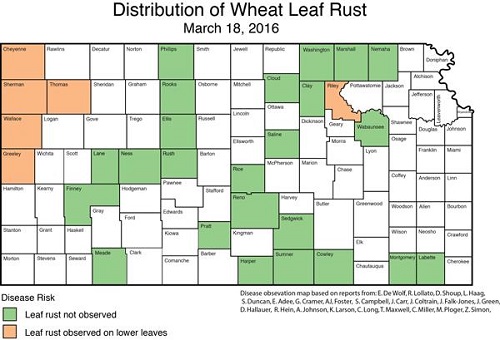
Figure 1. Risk of leaf rust in Kansas-March 18, 2016
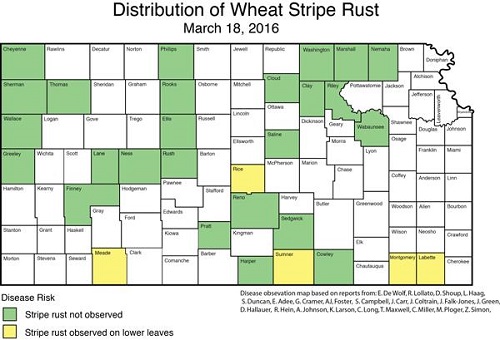
Figure 2. Risk of Stripe Rust in Kansas-March 18, 2016
What does this mean for wheat growers in Kansas?
The early reports of leaf rust and stripe rust are cause for concern. The risk of disease outbreaks and disease-related yield loss increases dramatically when the rust becomes established in the state prior to heading. Reports of increasing disease in Oklahoma and Texas suggest that, if weather conditions are right, more disease may move into the state soon.
What might growers consider doing to prepare for possible disease problems?
The most important thing growers can do at this stage is check their fields for disease. Scouting can help inform critical decisions about fungicides that will need to be made soon. Checking wheat varieties reaction to rust can help growers set priorities for scouting. Everest, Armour, TAM 112, and TAM 111 are widely planted in state. All of these varieties are susceptible to stripe rust and should be monitored carefully for symptoms of stripe rust. In western Kansas, where leaf rust has been more active, TAM 111 and TAM 112 are a top priority for scouting for disease because these varieties are susceptible to both rust diseases.
Fungicide options and considerations
Growers may also begin to gather information about fungicides options. Growers have access to many excellent product options. However, the price of these products and applications will be particularly important this year because the value of wheat grain is lower relative to some recent years.
The timing of these applications is also very important. Research has demonstrated that a single fungicide application applied between boot and flowering stages of development results in maximum yield benefit.
Fungicide applications made prior to jointing, followed by second application may also be an option. In K-State tests, these two application programs rarely result in much additional yield. It is the second application, between boot and flowering, that does the heavy lifting in terms of yield response. Also, keep in mind that label restrictions often specify the total amount of active ingredient that can be applied to a crop. Using a low-cost option early could limit the product options later in the season when a second application is needed to protect the upper leaves.
One final note of caution. Keep an eye on the forecast. It may be unwise to apply a fungicide when there is a significant risk of a freeze event or other hazard on the horizon that can limit the crop's yield potential. It is a good idea to be checking for disease and making other preparations for a potential fungicide application if conditions are right. It will be important to gather information and make a good decision in what looks like a challenging wheat production year.
Erick De Wolf, Extension Plant Pathology
Romulo Lollato, Wheat and Forages Specialist
from Jeanne Falk Jones, K-State Multi-County Agronomist
I received some reports of leaf rust to the south of us (Greeley Co) last Friday, showing up in the greening up wheat. It is showing up in the biggest and "rankest" wheat, that had plenty of growth last fall. It is not showing up in the smaller wheat.
Many times, I see leaf rust on wheat in the fall. The "freeze and thaw" cycles and dehydration are enough to kill off the fungal disease because of tip dieback of the older leaf tissues during the winter. Leaf rust must have live and viable tissue to continue to reproduce.
I was out looking at wheat a great deal of the weekend in Sherman and Cheyenne counties. I didn't find any leaf rust. In two cases, I went to fields that I found leaf rust last fall, but am not finding it now. I plan to look at wheat in Wallace county early this week and will let you know what I find.
While there is concern to already see leaf rust, it should be noted to continue to increase, it has to keep up with the wheat growth. It first has to move off the older growth to the newly emerging leaf growth. Then we need to have the right conditions for it to continue to produce viable spores for new infections. It needs moisture on the leaf surface for infections. It may be more concerning if it moves onto the newly emerging wheat and there are no more temperatures projected to be below freezing.
I was questioning the viability of the spores that are currently being produced. I spoke to Erick De Wolf, the K-State wheat pathologist. He said that the spores being produced are likely viable, but not all of them will cause a full-blown pustule. The spores themselves are subject to dehydration and cold temperatures. He also noted that the release of spores is a continual cycle (meaning that they are not all released in a very short window, but are released over a period of a couple days). This may allow more leaf rust spores to find suitable conditions for survival. One of the best things for suppressing this disease is overnight temperatures below freezing.
All in all, I don't think applying a fungicide for leaf rust before jointing is a good use of your money. Leaf rust infections before jointing have very little (if any) impact on yield. I know budgets are tight this year. I am also concerned that this year may be setting up to be a stripe rust year. Because of that, save your "fungicide line" in your budget for when we can make a difference in yield...at flag leaf.
If you are going out to look at your wheat for the leaf rust, I would pick the earliest planted wheat that you have because it generally has the largest plants. Look at the bottom leaves of the plant for raised pustules that will appear randomly scattered on the leaf surface. They will be orange if they are releasing spores. I have attached a picture that was sent to me from a field in Greeley county.
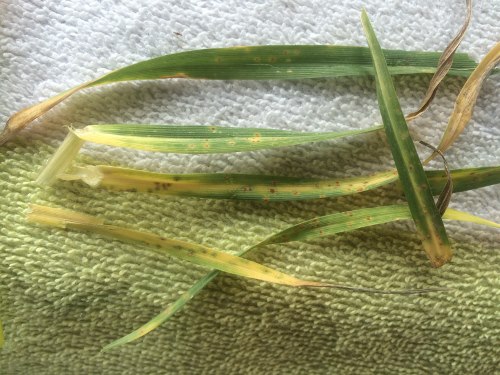
Finally, if you are out and about in your wheat field and find something interesting, please let me know! I really appreciate your reports. It can really help getting in front of diseases and insects, instead of playing catch up.
P.S. There are other diseases that early fungicide applications can provide important levels of control. One such disease is tan spot and it is generally found in continuous wheat fields.
Wheat Disease Update (2/10/16)
from Jeanne Falk Jones, K-State Multi-County Agronomist
How soon will we know if stripe rust will be affecting wheat this spring? Actually, the end of February and the month of March can be telling months, when looking at predictive models for the disease.
This is because we are looking to see how stripe rust is progressing in Texas and into the southern portions of Oklahoma. If they have moist growing conditions, then the outlook for stripe rust increases for our area. If conditions are dry, there can be leaf tip dieback on the wheat. This usually happens on the infected tissue and can decrease the likelihood of stripe rust making it to northwest Kansas.
There has been a great deal of work at K-State in developing prediction models for leaf and stripe rust. K-State Extension wheat pathologist, Erick DeWolf is heading up those efforts. His graduate student has been validating the models over the last couple of years. Consequently, these models are becoming more refined and better at predicting outbreaks of the diseases.
Currently, (in mid February) there are trace levels of stripe rust found in very southern Oklahoma and Texas. In many cases, these trace levels were also present last fall. The presence of the stripe rust right now should not be concerning because this is not uncommon.
All in all, we should not be concerned about a stripe rust outbreak at this time because it is just too early to tell. Stay tuned for updates about wheat diseases throughout the growing season!